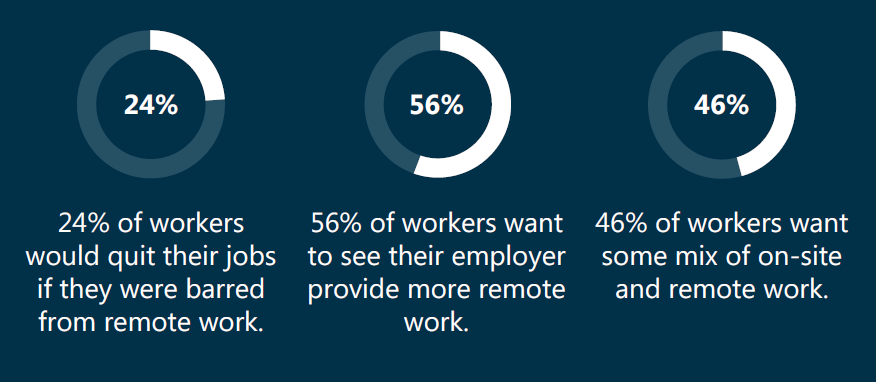The Great Reconsideration: Looking Ahead to the Next Stage of the Labor Market
This article is from RISQ Consulting’s Zywave client portal, a resource available to all RISQ Consulting clients. Please contact your Benefits Consultant or Account Executive for more information or for help setting up your own login.
The labor market continues to be unpredictable and driven by new challenges. As such, economists have signaled that the labor market is moving into another phase. Previously, there have been trends labeled as the Great Resignation and the Great Reshuffle. The Great Resignation referred to a mass movement of workers leaving the workforce. In contrast, the Great Reshuffle illustrated workers quitting one job they are unsatisfied with to take another—which has been a more accurate assessment. There has not been a mass exodus from work itself, as the term the Great Resignation suggested. While these terms still hold some truth to the current state of the market, some economists have even used a new term to describe the current worker sentiment: the Great Reconsideration. Instead, workers are seizing the unprecedented opportunity to reconsider and change their work experiences. They’ve had time to reflect on their jobs and consider opportunities with a fresh perspective.
This article examines the current labor market, highlights driving trends and offers tips for employers navigating the market.
Market Overview
The most recent U.S. Bureau of Labor Statistics (BLS) report revealed that the number of job openings rose to 11.2 million in July. This number was well above the estimate and still outnumbered unemployed workers by about 5.5 million. The July BLS numbers reinforced that there is still a considerable shortage of workers for available positions, with openings outnumbering available workers by a nearly 2-to-1 margin.
Employee quits, a top worker confidence metric, dropped from a record-high 4.53 million in March to 4.18 million at the end of July. The report also revealed that the employee quit rate declined one tenth of a percentage point to 2.7%. Nonetheless, this number is still relatively high by historical standards.
Additionally, the unemployment rate has not yet reached pre-pandemic levels. In July, the rate sat at 3.7%. In a regular labor market, this could be a troubling sign; however, it indicates that the job market could be on its way to normalizing. From a retention and attraction perspective, these numbers further illustrate that it’s a worker-friendly market.
The struggle to fill positions and related challenges have increased labor costs for employers as they raise wages and offer competitive benefits and other perks to attract talent. The market trends also demonstrate that workers remain confident enough to switch jobs for better pay and working conditions despite economic pressures like inflation.
Driving Trends
The COVID-19 pandemic undoubtedly shifted the playing field for workers and organizations. Now, amid the Great Reconsideration, both parties are reevaluating various aspects of the workplace and the workday.
Many employers are reassessing what workplace accommodations or transformations have—or have not— worked and what can be done to improve employee engagement and satisfaction. Simultaneously, workers are reconsidering their career goals and expectations for an employer.
Hybrid Work
Hybrid work continues to be a catalyst for modern workplace challenges. As such, more on-site workers want to leave their jobs than remote workers, according to a survey from professional services network KPMG. Consider the following additional statistics:

Many workers desire a hybrid workplace model to have more face-to-face time with their co-workers. The camaraderie with colleagues is a top reason why workers want to be in the office or similar settings part-time. Other motivators include creating a work-life balance, getting out of the house or benefiting from a regular change of environment. In the end, workers are looking for solid and united company cultures—and employers have an opportunity to act on this desire as they reconsider their workplace expectations and strategies. Employers who embrace hybrid work models may see improvements in employee productivity, morale and, most critically, retention.
Long COVID and the Labor Market
Long COVID-19—long-term effects stemming from COVID-19 infection—continues to impact the labor market and employees’ health. The U.S. Census Bureau’s latest Household Pulse Survey found that 16.3 million working-age Americans currently have long COVID. It has been reported that long COVID is even keeping some workers out of employment; an estimated 4 million workers are out of the labor market, according to Brookings Institution’s nonresident senior fellow Katie Bach.
Long COVID can pose serious risks for employers, including decreased productivity and the loss of employees from the workforce entirely. Therefore, they must stay up to date on trends surrounding the condition’s rates and other related topics, such as strategies other employers are using to respond to long COVID.
Salaries and Job Hopping
HR services provider ADP reported that salaries have been increasing rapidly, nearly on par with inflation. Annual pay raises rose by 7.6% in the period leading up to August 2022, compared to an average of 2% in early 2021. However, the most significant raises went to job hoppers. Those who found different jobs experienced salary gains of 16.1%, while employees who stayed loyal to a company received an average increase of 7.6%.
Looming Recession
As the Federal Reserve struggles to tame skyrocketing prices, employers and employees alike are worried about entering a recession. Some might even say a recession has already begun. The reality for many business owners due to the employment market is slower growth and rising labor costs. As a result, many organizations have experienced or are planning layoffs and hiring freezes in the back half of this year.
What Are Employers Doing?
Although the Great Reconsideration is currently taking place, new labor challenges will likely surface. All employers can do is face the moment and put together a game plan. As a thought-starter, here are strategies some organizations are using to win over talent:
- Review compensation. As employers and employees continue to be hit by inflation, organizations should start reviewing and assessing their current compensation and benefits. It could be helpful to analyze pay raises from similar companies based on industry or geographic location.
- Reimagine company culture. Just as workers are reconsidering what they want for work and an employer, an organization can reevaluate its goals and what kind of employer they want to be. Company culture can be an organization’s best protection against losing employees—and offer a leg up on attracting new employees. There is usually a gap between organizational leadership and what employees experience, so there’s a need to keep it aspirational but realistic.
- Rethink perks. Flexibility is no longer a generous workplace perk. It’s a significant perk, but many employees already have a flexible working schedule or expect it from prospective employers. With remote or hybrid work becoming table stakes, employers will have to stand out against the competition with other unique perks (e.g., four-day workweek and flexible hours).
- Prioritize real-time over real-life connections. Workplace connection has often been thought of as something that happens during the workday in the hallway, at the coffee station or in other communal areas. However, employers can still plan for real-life connections without requiring employees to be working on-site all day. This can be achieved by making real-time communication a habit for employees by providing tools, opportunities and encouragement to connect. Employers are considering ways to create intentional spaces for peer connection that don’t necessarily involve day-to-day work.
- Invest in career growth. With many workers reevaluating their career goals and paths, employers can invest in workers by expanding learning and development opportunities. Employers can enhance their staffing and worker skill levels by offering employees a chance to enrich their careers via upward mobility. Forward-thinking organizations will plan to recruit and retain employees for the skills needed today—and in the future.
In the end, many employers are reinventing their company culture to account for adjusted organizational mission and values, company culture and employee expectations.
Summary
Generally, job openings remain high as the demand for workers outweighs the supply. Many employers are at a disadvantage and struggling to fill positions. Unfortunately, experts expect talent challenges to continue. Yet, forward-thinking organizations are benefiting when they remember that workers are human. Workers are looking for an employer who matches their style, needs and beliefs. They want to work where they feel care and support from their employers. As the Great Reconsideration is in progress, employers will have to find ways to make their culture and workplaces look and feel authentic and reliable. Employers should continue to monitor employment trends in the evolving market to stay competitive. Contact us for more resources.
- Published in Blog
Understanding the “Quiet Quitting” Trend
This article is from RISQ Consulting’s Zywave client portal, a resource available to all RISQ Consulting clients. Please contact your Benefits Consultant or Account Executive for more information or for help setting up your own login.
“Quiet quitting” is an emerging trend where workers only do what their job description entails without going above and beyond. Over the course of the COVID-19 pandemic, many employees shifted their views on their work lives, and this has been reflected in movements such as the Great Reshuffle—a mass movement of workers to jobs that meet their demands for things such as more flexibility and better benefits—the shift to remote work and, now, the quiet quitting trend.
Employees who solely complete their job description and no more could continue to be valuable workers. However, employers can consider steps to engage employees and prevent quiet quitting from happening in the first place. To help eliminate the trend’s presence in their organizations, employers should focus on effective communication with their employees and methods to enhance employee engagement.
Signs of Quiet Quitting
Research conducted by Gallup found that only 32% of employees are engaged, and 17% are actively disengaged. Employees who are not engaged could be at risk for doing only their job and not going above and beyond. Further, 53% of workers reported they feel burnt out, according to Talkspace’s Employee Stress Check 2022 Report. To improve employee engagement and prevent these issues from turning from quiet quitting into actual quitting, employers need to know what signs to look for. Employers should pay attention to employees who are consistently doing the following:
- Not attending meetings that are not mandatory
- Not being as productive as they once were
- Contributing to team projects less
- Not participating in meetings
- Displaying a lack of enthusiasm
It is important to know that there a several reasons an employee may choose to quiet quit. For example, they may simply refuse to do work outside their job description because they feel they are not being compensated for it. While it may not be clear why an employee is choosing to quiet quit, these signs are a good indicator that an employee may be thinking about it or trying to do so.
What Employers Can Do
Quiet quitting is often the result of decreased motivation and burnout. Further, a lack of effective communication between leaders and employees and a general failure of management and organizations can play a role. For example, failures may include a lack of honesty with employees and not delivering on promises. Consider the following ideas to help improve employee engagement and decrease the odds of quiet quitting among employees:
- Provide clear job descriptions. Job descriptions let employees know exactly what is expected of them. Employers should review job descriptions to ensure they accurately reflect the duties they expect their employees to perform.
- Conduct performance reviews. Performance reviews are opportunities to reward employees for the positive things they have done and inspire them to continue working hard. Without this feedback and indications of appreciation for hard work, such as title adjustments and salary raises, employees could lack motivation and start to feel burnt out and consider quiet quitting. Further, it is important to recognize employees who go above and beyond because they are likely to feel discouraged and decrease their performance if their contributions go unnoticed. Conversely, performance reviews are just as important for underperforming employees because they are opportunities to clearly communicate expectations and work together to correct the behavior.
- Educate employees on employee handbooks. Employee handbooks are another tool employers can use to clearly communicate expectations to employees, but they are only truly effective if employees understand them. Employers should take time to educate employees on their handbook and its policies so they can ensure employee understanding. The handbook should be reviewed and updated regularly to ensure that expectations are up to date and that organizations are in compliance with current laws.
- Provide learning and development opportunities. High employee engagement is crucial to preventing quiet quitting. One effective way to increase engagement is through learning and development initiatives. According to Zywave’s 2022 Attraction and Retention Benchmarking Overview, 29% of employers found career development opportunities to be a top priority of workers during the hiring process. Employees who have these opportunities are more likely to remain engaged and stay motivated to try their best at their jobs.
- Focus on good management strategies. Effective management is essential to having efficient, happy employees, so it is important to focus on the techniques managers use. Provide resources to managers about effective strategies and meet with them to discuss ways they can improve. Further, consider conducting skip reviews, where employees talk with their manager’s manager to discuss feedback or concerns they may have. This will allow the manager to receive helpful feedback that can be mutually beneficial and improve their employees’ experiences.
Takeaway
Quiet quitting is the new term for the trend of employees doing only what their job requires without exceeding expectations. Employers should be aware of the trend and that it will impact every workplace differently. Employers should monitor for signs that employees may be disengaging and utilize different strategies to help prevent quiet quitting. In cases where quiet quitting may be negatively impacting the employer and they cannot seem to resolve the issue, employers should ensure compliance with federal and local employment laws before pursuing any termination action. For specific guidance about disciplining employees, employers are encouraged to seek local legal counsel.
Contact RISQ Consulting today for more information on workplace trends, employee retention and employment laws.
- Published in Blog
What President Biden’s Vaccine Mandate Means for Employers
This article is from RISQ Consulting’s Zywave client portal, a resource available to all RISQ Consulting clients. Please contact your Benefits Consultant or Account Executive for more information or for help setting up your own login.
President Joe Biden’s administration is continuing its efforts to curb the COVID-19 pandemic and the spread of the deadly coronavirus Delta variant. Recently, the White House ordered all federal workers and contractors to get vaccinated against COVID-19. Now, the government is imposing a similar requirement on private employers. The move is estimated to affect over 80 million private-sector workers.
The Occupational Safety and Health Administration (OSHA) has been tasked with drafting an emergency temporary standard (ETS) and will announce more specifics in the coming weeks. Soon, employers with 100 or more employees will need to adapt their vaccine policies to comply with these new rules.
This article discusses this latest vaccination mandate, including its scope and how it may affect employers.
Note: This is a developing issue. Information will be updated here and in subsequent resources as more details are released.
Rule Overview
Soon, employers with 100 or more employees (measured companywide, not by location) will need to enforce one of the following:
- Require employees to get vaccinated against COVID-19
- Require unvaccinated employees to produce evidence of a negative COVID-19 test each week
This flexibility allows employers to choose how strictly they want to enforce a vaccine mandate. In other words, some employers may decide to make vaccination a condition of employment; others may only require negative COVID-19 tests.
What’s Known About the Upcoming Rule
OSHA is tasked with drafting the new rule. As such, there will be few details available before OSHA publishes a definitive ETS. Meanwhile, the only pertinent information has come from short government briefings.
Here’s what’s known about the upcoming rule, keeping in mind these particulars may change in time:
- The rule will only apply to employers with 100 or more employees, measured companywide.
- Employers will be able to decide if they want to adopt a strict, mandatory vaccination policy or allow testing as an alternative.
- Employers must provide paid leave to receive and recover from vaccinations.
- Remote employees not working in contact with others will be exempt from the ETS (unless they come into the workplace).
Again, all aspects of this upcoming rule are subject to modification as OSHA continues to work on the details. The above information is provided to help employers understand how the government is proceeding in this area.
What’s Unknown About the Upcoming Rule
Much is still unknown about the upcoming vaccine requirement, and it will remain as such until OSHA publishes the ETS. Here are just some of the questions that remain to be answered:
- When will the ETS begin being enforced?
- What qualifies as proof of vaccination or a negative COVID-19 test?
- Who must pay for weekly testing?
- What specific penalties will there be for noncompliance?
- Will the mandates apply to part-time workers?
- Will there be new guidance on how employers should handle accommodations for employees seeking an exemption?
- Must paid leave be provided for employees’ COVID-19 testing, as it is for vaccinations?
As the list illustrates, there are many unknown factors at this time. Employers will need to stay tuned for updates from OSHA as they come; however, that employers can take action in the meantime.
Expected Enforcement Timetable
The vaccination mandate will come in two primary waves:
- An ETS with comprehensive details and actionable steps
- A permanent OSHA standard with all aspects fleshed out
First, OSHA will publish its ETS that will include important details and enforcement guidelines. This is expected to come in the weeks ahead; however, an actual release date is uncertain. Once issued, the ETS will take immediate effect in states where federal OSHA has jurisdiction. In states where the federal government does not have jurisdiction over workplace safety, state agencies will have to either adopt the ETS or develop their own ETS within 30 days that is “at least as effective.”
An ETS can only remain in effect for six months. After that time, it must be replaced by a permanent standard, which must undergo a formal rule-making process involving a notice-and-comment period to allow stakeholders to submit feedback. This process follows the usual procedure for adopting a permanent standard except that a final ruling should be made within six months from that date OSHA publishes the ETS in the Federal Register.
In summation, employers can expect the ETS sometime within the year, but its specifics may ultimately change as the standard is finalized.
What Employers Can Do Now
While many details are still unknown, the primary vaccination or testing requirement is definite. As such, employers can at least prepare for this aspect of the mandate. Here are some actions employers can consider when preparing for the upcoming requirement:
- Determine whether COVID-19 vaccination will be required as a condition of employment or if weekly negative testing will be an alternative.
- Consider how to handle accommodation requests for those seeking vaccination exemptions.
- Start planning an employee communication campaign to educate workers about vaccine policy changes.
- Think about the systems needed to adequately track employee vaccination statuses and confidentially secure the data.
- Plan for potential staffing shortages or scheduling changes to afford employees time to get vaccinated.
- Consider whether partitions or spaced-out workstations will be utilized
This list is nonexhaustive, as certain considerations will be unique to individual employers.
Though the ETS will almost certainly face multiple legal challenges, employers should not count on the rule being entirely struck down and should begin preparing to comply as soon as possible.
Conclusion
The specifics of this latest vaccine mandate are still being drafted, so its rules may seem like a distant concern; however, these requirements will take effect quickly once they’re announced. Employers will need to act swiftly when the time comes to ensure compliance. Taking proactive steps now can help save employers from a scramble at the end of the year.
Reach out to RISQ Consulting to discuss how this new rule may affect your business. In the meantime, stay tuned for updates as this situation develops.
- Published in Blog




